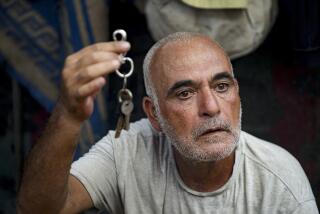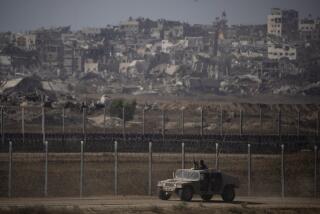Seven months after Gaza war, devastation remains, wounds are still fresh

Almost seven months after the cease-fire that ended a devastating war in the Gaza Strip between Israel and the militant group Hamas, the fighting’s ruinous effects are visible everywhere in this ragged coastal enclave.
Reconstruction efforts have barely gotten off the rubble-strewn ground. Electricity flickers feebly through just six to eight hours each day. The economy, never robust, is in tatters. Government salaries mainly go unpaid. The infighting between Hamas, still the dominant power in Gaza, and the West Bank-based Palestinian Authority has grown even more bitter after a stillborn unity accord.
Egyptian-hosted talks meant to lead to a durable peace agreement between Israel and Hamas never materialized. Movement of people and goods in and out of the seaside territory is improving, but still tightly limited by the Israelis. And although summertime swelter was the backdrop for 50 days of fighting in July and August, tens of thousands of people were inadequately sheltered this winter against the biting cold, driving rain and scouring sandstorms.
Gaza’s woes, which feed the seething anger many of its residents feel toward Israel, remains one of the more intractable problems facing Prime Minister Benjamin Netanyahu, who is expected to remain in power after this week’s elections gave his Likud party the inside track on forming Israel’s next government. He has steadfastly refused to negotiate with Hamas, viewed by Israel as a terrorist organization.
Netanyahu will be under increasing international pressure to demonstrate how his new government, if he can form one, can address the long-standing problem of Palestinians under Israeli occupation after a hard line on security formed a centerpiece of Likud’s successful election campaign.
For Gaza residents still struggling to get past losses in the last war with Israel, a miasma of depression has settled in like morning mist.
“I cry every day,” said Montaha Kafarna, a 37-year-old Palestinian mother of nine, gesturing toward the cramped storage room where she lives with her family in a school converted into a U.N.-run center for the displaced. “I think we will still be living here when the next war comes.”
Long after the cease-fire in late August, recrimination abounds on all sides. Israel reacted with fury when the Palestinian Authority recently moved to join the International Criminal Court with the aim of holding Israel to account for alleged war crimes, including some episodes in the Gaza fighting. Netanyahu’s government is withholding hundreds of thousands of dollars in tax revenue, the Palestinian Authority’s financial lifeblood, in retaliation.
During the war, Israel accused Hamas of using Palestinian civilians as human shields by firing hundreds of rockets at Israel from populated areas. Palestinians and international rights groups decried Israel’s use of battlefield munitions — whose aiming mechanisms were not always precise — in densely populated neighborhoods.
There is continuing angry debate over what proportion of the more than 2,100 Palestinians killed were militants. The United Nations and human rights groups say most were civilians, including about 500 children; Israel says hundreds of the dead were Hamas fighters. The 72 dead on the Israeli side were nearly all soldiers; the civilians killed included a 4-year-old boy and a Thai farmworker.
The overall conduct of the war became an issue in Israel’s election campaign — an overarching theme being the belief on the part of many that Israel failed to achieve its war aims.
Netanyahu’s main opposition, the Zionist Union, rolled out commercials featuring ominous narration and claustrophobic inside-the-tunnel video of the well-reinforced subterranean passageways that Hamas constructed under Gaza as well as beneath the boundary fence surrounding the territory. Netanyahu in turn hit hard on the theme that in a region filled with enemies of Israel, not least Hamas, he could be relied upon to guard Israel’s security.
Particularly in communities close to the boundary, many Israelis nonetheless feel profoundly betrayed by what they consider the security establishment’s previous inaction on the tunnels, whose existence had long been known.
Even during the conflict, Israelis wondered whether the fighting was neutralizing the Hamas threat. In retrospect, those doubts have magnified. A poll last month found that 20% of respondents believed that Hamas had won the war, up from the 4% in August during the conflict who thought the militant group was winning.
Hamas, which recently has been test-firing rockets into the Mediterranean, makes no apologies for seeking to rearm. “Why not?” spokesman Taher Nono said. “We are not looking for war, but there is a threat from the Israeli side to make new aggression against us.”
Hamas, whose popularity rises during confrontations with Israel, seeks to portray itself as the sole defender of the Palestinian people, scorning figures such as Palestinian Authority President Mahmoud Abbas for taking part in past conciliation efforts. In Gaza, which has seen three wars since Hamas came to power in 2006 elections, looming billboards feature fiery images of armed fighters and slogans such as, “Occupier, we are coming to you. Leave or die.”
On the Israeli side, some commentators believe there is little will to address the risk of renewed fighting posed by miserable conditions in Gaza.
“Israel knows this war will break out,” columnist Gideon Levy, who received death threats for criticizing Israeli military actions, wrote last month in the left-leaning daily Haaretz. “It also knows why — and it’s galloping toward it blindfolded, as though it were a cyclic ritual, a periodic ceremony or a natural disaster that cannot be avoided.”
In the conflict’s immediate aftermath, international donors pledged $5.4 billion in aid to rebuild the battered enclave, but almost none has made its way to those needing it. In districts like Khan Yunis, heavily bombed during the fighting, wind rattles the plastic sheets that patch buildings whose facades have been sheared off like dollhouses. Corrugated tin is nailed over gaping shell holes.
More than 100,000 homes across Gaza were destroyed or badly damaged in the fighting. Those relatively few residents moving ahead with repairs have the financial means to purchase building materials on the black market.
“If I waited for anyone’s help, my family would be living like nomads forever,” said Iyad Radwan, whose family fled in terror when their apartment building in the Shati refugee camp was smashed by the bomb-toppled minaret of a landmark mosque across the street. Going into debt, he said, was better than being homeless.
The British aid group Oxfam said last month that it could take decades to rebuild homes, schools and hospitals in Gaza. For that slow pace, all sides point accusatory fingers.
Israel says that if building materials arrived unchecked, they would find their way into the hands of Hamas for more tunnel building.
The Palestinian Authority says the importation of construction supplies has been curtailed in part by Hamas’ refusal to relinquish security control along the border, as Israel demands.
Hamas accuses Israel of deliberately leaving Palestinians to suffer and says the international community was insincere in its expressed desire to help with rebuilding and recovery.
During the fighting, many Gazans believed that Hamas was striking a blow to break the siege clamped on the territory since 2007 when Egypt and Israel all but closed their land crossings after the militant group drove Abbas’ Fatah fighters out of the enclave. The Israeli nonprofit group Gisha, which works to aid movement of people and goods to and from Gaza, says that from last summer’s cease-fire until the end of the year, a mere 3.9% of the construction materials needed to repair damage entered Gaza.
Gazans in general feel forgotten by the outside world. The war drew global attention, but an array of crises in its aftermath — Ebola, Ukraine, the growing reach of the militants of Islamic State — have taken the spotlight.
In the meantime, the conflict’s fallout blights not only the present but also the future. Mahmoud Abu Riziq, 19, who had received a scholarship to attend college in Algeria, recently spent six days and chilly nights at the Rafah border crossing into Egypt, hoping to be allowed to pass.
Egypt, conducting an intensive military campaign against Islamic militant groups in the northern Sinai Peninsula, has kept the crossing closed almost continuously and is demolishing hundreds of homes on its side of the frontier to create a buffer zone.
“I’m so, so disappointed,” Abu Riziq said of his failed effort to leave Gaza behind. “It’s not just time being thrown away. It’s the possibility to have a better life. To make something of myself. To achieve something.”
Twitter: @laurakingLAT
Special correspondents Batsheva Sobelman in Jerusalem and Maher Abukhater in Ramallah contributed to this report.
More to Read
Sign up for Essential California
The most important California stories and recommendations in your inbox every morning.
You may occasionally receive promotional content from the Los Angeles Times.










